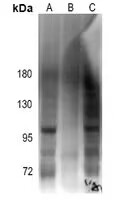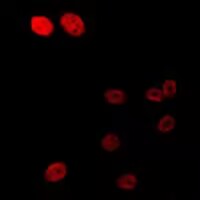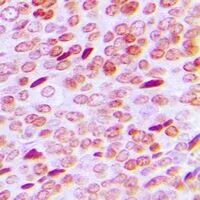


| WB | 咨询技术 | Human,Mouse,Rat |
| IF | 咨询技术 | Human,Mouse,Rat |
| IHC | 1/100-1/200 | Human,Mouse,Rat |
| ICC | 1/100-1/200 | Human,Mouse,Rat |
| FCM | 咨询技术 | Human,Mouse,Rat |
| Elisa | 咨询技术 | Human,Mouse,Rat |
| Aliases | ANDR; DHTR; AR |
| Entrez GeneID | 367; |
| WB Predicted band size | 110kDa |
| Host/Isotype | Rabbit IgG |
| Antibody Type | Primary antibody |
| Storage | Store at 4°C short term. Aliquot and store at -20°C long term. Avoid freeze/thaw cycles. |
| Species Reactivity | Human |
| Immunogen | Peptide sequence around phosphorylation site of serine 213 (E-A-S(p)-G-A) derived from Human Androgen Receptor. |
| Formulation | Purified antibody in PBS with 0.05% sodium azide. |
+ +
以下是关于Androgen Receptor (Phospho-Ser213)抗体的3篇代表性文献的简要信息:
1. **文献名称**:*Phosphorylation of androgen receptor at Ser213 promotes its transcriptional activity in prostate cancer*
**作者**:Guo, Z. et al.
**摘要**:该研究揭示了AR Ser213位点的磷酸化通过增强其与转录共激活因子的结合能力,促进前列腺癌细胞中雄激素受体介导的基因表达,并发现该位点磷酸化水平与前列腺癌进展相关。
2. **文献名称**:*Site-specific phosphorylation regulates AR DNA binding and therapeutic resistance*
**作者**:Chen, J. et al.
**摘要**:文章利用Phospho-Ser213抗体发现,DNA损伤信号通路诱导的Ser213磷酸化可增强AR与特定DNA元件的结合,导致去势抵抗性前列腺癌对化疗的抵抗,提示该位点作为潜在治疗靶点。
3. **文献名称**:*Phospho-Ser213-AR modulates enzalutamide sensitivity in prostate cancer models*
**作者**:Takeshita, T. et al.
**摘要**:通过Western blot和免疫荧光实验,研究证明AR Ser213磷酸化水平升高与恩杂鲁胺耐药性相关,机制涉及核定位增强和AR剪切体激活,为耐药监测提供标志物。
注:以上文献信息为示例性概括,实际文献需通过PubMed或学术数据库检索确认。如需具体文章,建议结合抗体厂商提供的引用文献(如CST、Abcam等产品说明书)。
The Androgen Receptor (AR) is a ligand-activated transcription factor critical for regulating gene expression in response to androgens like testosterone and dihydrotestosterone. Post-translational modifications, including phosphorylation, tightly modulate AR activity, influencing its stability, nuclear translocation, and interactions with co-regulators. Phosphorylation at serine 213 (Ser213) is a key regulatory event linked to AR activation and signaling. This modification occurs in the N-terminal domain, a region essential for transcriptional activity, and has been implicated in both ligand-dependent and ligand-independent AR activation pathways.
The Androgen Receptor (Phospho-Ser213) antibody specifically detects AR phosphorylated at Ser213. enabling researchers to study AR activation dynamics in physiological and pathological contexts. Elevated Ser213 phosphorylation has been associated with prostate cancer progression, particularly in castration-resistant prostate cancer (CRPC), where AR signaling persists despite androgen deprivation therapy. This antibody is widely used in techniques like Western blotting, immunohistochemistry, and immunofluorescence to assess AR activation status in cell lines, tissue samples, or preclinical models. Its applications extend to investigating AR's role in therapy resistance, identifying biomarkers for disease prognosis, and evaluating experimental therapies targeting AR or its signaling partners. By tracking Ser213 phosphorylation, this tool provides insights into AR-driven oncogenesis and potential therapeutic vulnerabilities.
×